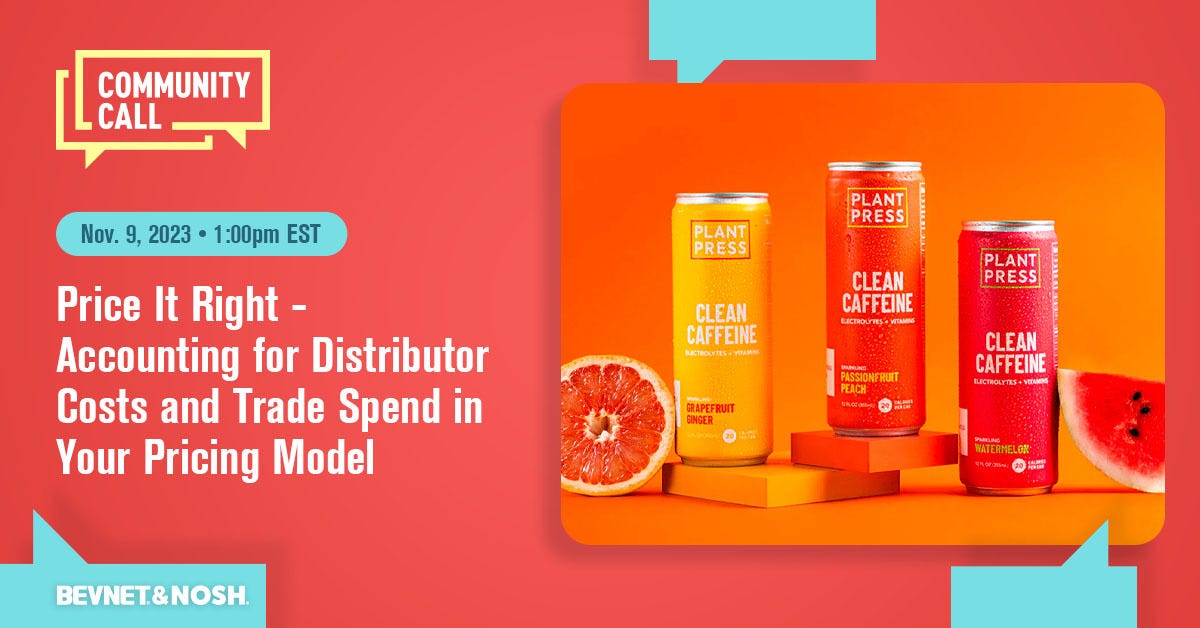Rao’s, Prego, and Campbell Soup Insights (and an event this week)
First, the event: I’m excited to announce that I’m joining a BevNet/Nosh Community Call with the founder of Plant Press, where I’ll be coaching her live on creating a pricing model for her innovative beverage line. I invite you to join us for this interactive session on Thursday November 9 at 1pm Eastern.
LinkedIn event page
Zoom registration
Now, onto Rao’s. The social media landscape was astir with the news that Campbell Soup was acquiring Sovos Brands, maker of Rao’s pasta sauce (WSJ gift link). Rao’s has cultivated a devoted following, with consumers who pay $10 per jar for its award-winning sauces. The news of Campbell’s acquisition bled from the financial world into consumer circles, with many fans seriously worried that Campbell’s might dilute Rao’s quality.
What many don’t realize is that Campbell’s owns Prego and they are using Rao’s to augment its pasta sauce share. And that the story of Prego has some parallels to Rao’s.
Over forty years ago, Campbell's innovated with pasta sauce by developing Prego. It’s hard to imagine that back then, many consumers were suspicious of pre-made pasta sauce. But there were few varieties and the taste of packaged sauce fell short.
But Campbell’s R&D team was set on finding more uses for tomatoes other than soup and V8 juice. They developed a new technique for mass production of tomato sauce with the right texture quality, and Prego was successfully launched in the early 1980s. Prego filled a void.
As growth leveled off after the launch and competitors like Ragu grew, Campbell’s sought new growth levers.
They hired Howard Moskowitz in 1986. “Prego was a little thicker than Ragú, with diced tomatoes as opposed to Ragú’s purée, and, Campbell’s thought, had better pasta adherence. But, for all that, Prego was in a slump, and Campbell’s was desperate for new ideas.”
Malcolm Gladwell gave a TED Talk that explained Moskowitz’s research innovation and later wrote about it in the New Yorker. (He talks about Prego and pasta sauce starting around the 5 minute mark.)
Moskowitz used a new approach to consumer insights to identify growth paths. From the New Yorker article:
“Standard practice in the food industry would have been to convene a focus group and ask spaghetti eaters what they wanted. But Moskowitz does not believe that consumers—even spaghetti lovers—know what they desire if what they desire does not yet exist. ‘The mind,’ as Moskowitz is fond of saying, ‘knows not what the tongue wants.’ Instead, working with the Campbell’s kitchens, he came up with forty-five varieties of spaghetti sauce.… When Moskowitz charted the results, he saw that everyone had a slightly different definition of what a perfect spaghetti sauce tasted like. If you sifted carefully through the data, though, you could find patterns, and Moskowitz learned that most people’s preferences fell into one of three broad groups: plain, spicy, and extra-chunky, and of those three the last was the most important. Why? Because at the time there was no extra-chunky spaghetti sauce in the supermarket. Over the next decade, that new category proved to be worth hundreds of millions of dollars to Prego.”
If they had simply identified what the average consumer liked, they never would have found the insight that there was an important group who wanted extra-chunky pasta sauce. By using this then-novel approach to consumer insights, Campbell’s unlocked significant topline growth.
Whether with the same intentionality or not, Rao’s found something similar. They came to market with a $10 jar of pasta sauce at a time when the big brands would promote down to $1. I was working in the pasta sauce category at the time Rao’s was expanding. The general consensus was that Rao’s was insane to sell at that high price point.
But what I didn’t appreciate at the time was that there were enough people willing to spend extra money — and quite a lot extra — for a truly good product. Rao’s cracked that code. They paired it with a smart price promotion strategy, where they promoted frequently to allow trial and sold at better per-pound prices in alternate channels, like club warehouses.
Rao’s success and Campbell's new acquisition are not just about premium pricing or product quality but also about using insights to understand consumers palettes, which requires not just data but also insight and foresight.
Whether you savor the spicy, indulge in the chunky, or prefer the plain, the story of Rao’s and Prego reminds us that the secret ingredient to culinary and commercial triumph often lies in discerning the market’s unarticulated desires. Let’s relish the narrative that brought us here and anticipate the flavors yet to be discovered.
(View and share this article on LinkedIn.)
For more:
It’s In There!, a book written by a past Campbell’s food scientist
Best regards,
Scott Sanders
P.S. In the spirit of sharing simple things I find useful, I bought a cheap cell phone stand a few years ago and find that I use it nearly every day. It's helpful to see my phone at a glance at my desk without needing to hold it upright. And my kids and I use it when FaceTiming with family, removing the need to hold the phone. There are many but this one has worked well for me.
P.P.S. I’m sharing this article here on Substack for the first time as I begin to use it for hosting Shelf Talk. If you received this directly via email previously, let me know and I’ll sort out the duplicates.



